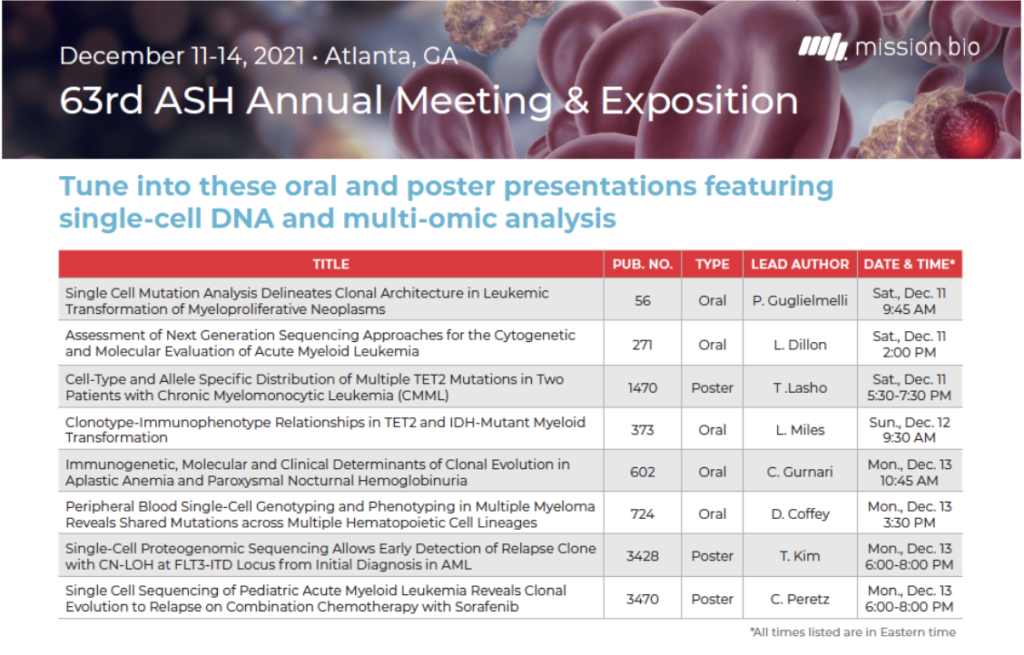We had such a blast at the 63rd Association of Society of Hematology (ASH) Annual Meeting and Exposition! This year, ASH held the first-ever hybrid annual meeting, where Attendees could either tune in via ASH’s web platform virtually or participate in person. The in-person meeting was held in Atlanta, Georgia on December 11-14.
There were over 13,000 attendees from around the world that participated in the ASH event in person. The hybrid meeting format provided more flexibility to the attendees and, most importantly, enabled discussions both on the conference stage and on social media channels like Twitter. These platforms provided such great opportunities for us to meet the community of hematologists and learn about their work. This also led to many great discussions and possible future collaborations with scientists and clinicians from all over the world. To bring you up to date, below are some highlights of the ASH conferences including several talks highlighting Tapestri data this year:
Understanding Disease Biology with Multi-Omics
In the “Clonotype-Immunophenotype Relationships in TET2 and IDH-Mutant Myeloid Transformation” talk given by Dr. Linde Miles from MSKCC Dr. Ross Levine’s lab, the study elucidated the clonal architecture and clone specific molecular profiles carrying TET2 or IDH1/2 mutant derived from the data generated from Tapestri single-cell multi-omics data from 146 patient samples and how the co-occurrence with some other driver genes in a sequential or parallel way could drive the myeloid transformation. The panel they used in this study is now available at Mission Bio as the Myeloid Evolution Published Panel.
Novel Therapeutics Update
There are also dozens of updates on recent clinical trials. Loxo Oncology from Lily announced their recent updates on Phase I/II BRUIN Clinical Trial on Pirtobrutinib (LOXO-305) to manage chronic lymphocytic leukemia/small lymphocytic lymphoma (CLL/SLL) and mantle cell lymphoma (MCL) shared by Anthony Mato, M.D., MSCE, director of the CLL Program at Memorial Sloan Kettering Cancer Center and Michael Wang, M.D., Puddin Clarke Endowed Professor of Lymphoma and Myeloma at The University of Texas MD Anderson Cancer Center. Pirtobrutinib demonstrated promising efficacy in both heavily pretreated CLL/SLL and MCL following multiple prior lines of therapy (Check out on Tapestri’s catalog panel on CLL and virtual MCL panel).
David A. Sallman, MD and Asmita Mishra, MD from H. Lee Moffitt Cancer Center and Research Institute shared recent updates of Phase I and II clinical trial of Eprenetapopt (APR-246), a small molecule that can reactivate the inactivated p53 protein, in combination with azacitidine for the frontline treatment of TP53 mutant AML or MDS. A following allogeneic stem cell transplantation (SCT) demonstrated safety and tolerability. Unfortunately, this drug with combination use of Azacitidine still failed the key Phase III trial to meet the primary statistical endpoint of complete remission and is currently on clinical hold in myeloid malignancies.
Progress in Clinical MRD
In the scientific workshop held on December 10th, several clinicians from the USA, Australia, and Germany including shared current novel minimal residual disease (MRD) measurement techniques and applications. New approaches involving flow cytometry were discussed, as well as NGS whole-genome sequencing (WGS) to detect large structural variants (SV) and copy number variants (CNV), the clinical utility of circulating tumor DNA (ctDNA) testing assays in hematological malignancies, and ultra-deep NGS and standardization for MRD assessment.
Dr. Andrew Wei also discussed the MRD-directed therapy as a new frontier in AML – they developed the INTERCEPT (INvestigational Targeted MRD in AML for Early detection of Relapse and Clonal Evolution to guide Pre-emptive Therapy) platform trial to treat the patients during an earlier stage of disease progression using a range of MRD detection technologies. The goal is to increase the frequency of and prolong the duration of complete remission (CR).
On December 13th, Aaron Llanso, Senior Director of Clinical Development of Mission Bio also delivered a presentation highlighting Tapestri’s single-cell multi-omics in advancing hematology research with clinical applications such as MRD, therapeutics resistance, and clonal hematopoiesis.
Understanding Clonal Hematopoiesis (CH)
Clonal hematopoiesis (CH) was also one of the emerging topics at ASH. Don’t know what CH is? Check out this blog post! Several sessions had a focus on recent CH projects, including epidemiological studies, the relationship of CH with aging, and the presence of CH in sickle cell disease. Dr. David Coffey from the University of Miami also presented data taken from 12 patients PBMC samples with multiple myeloma (MM) during diagnosis, remission, and relapse using Tapestri single-cell multi-omics technology. Clonal hematopoiesis mutations seem also to be observed in different cell types in the blood samples and were the most frequently mutated genes.
“One of the things I want people to take away from this study is that when you see one or two mutations in one of these genes and you’ve done bone marrow or blood sequencing that is bulk, you can’t be absolutely certain that it came from the plasma cell. It could’ve come from another cell type. So I hope this study sheds light on the fact that we need to be certain where the mutation came from and I think single cell DNA sequencing will continue to improve and is going to be more accurate when we define the mutational events in the tumor populations.” – Dr David Coffey, MD
New Tools in the Gene Editing Space
In the JOINT session, Gene Editing 2.0, a panel discussion was moderated by Dr. Simon Mendez-Ferrer from the University of Cambridge and NHSBT. Several researchers presented the most recent updates of gene editing strategies that do not involve generating double-strand DNA breaks (DSBs), including novel homology-directed repair (HDR) methods and cytosine and adenine base editors.
David Liu from the Broad Institute emphasized how DSB-involved gene-editing tools can potentially generate hazardous effects such as translocations. When he talked about the challenges of the current gene-editing methods:
“We have very little control over what those products are. You get mixtures. So when you see a bar graph that says percentage of editing, you have to realize that you are looking at a bar with INDELs that are considered gene-edited. When you are getting 95% editing, that doesn’t mean you are getting 95% of one thing, you are actually getting mixtures of hundreds of different alleles.” — David Liu, PhD
In case you missed some of the talks we mentioned above, all meeting attendees have access to the virtual meeting platform through the end of their registration period! So don’t forget to tune in and watch the on-demand sessions including below highlighting Tapestri single-cell multi-omics data!

All in all, ASH this year was a huge success and fostered great discussions among hematology professionals. At Mission Bio, we are always excited to attend this conference and see what exciting new research is happening in the hematology field. We always enjoy catching up with our customers and meeting new people that are interested in using single-cell analysis to gain deeper insights from their data.











